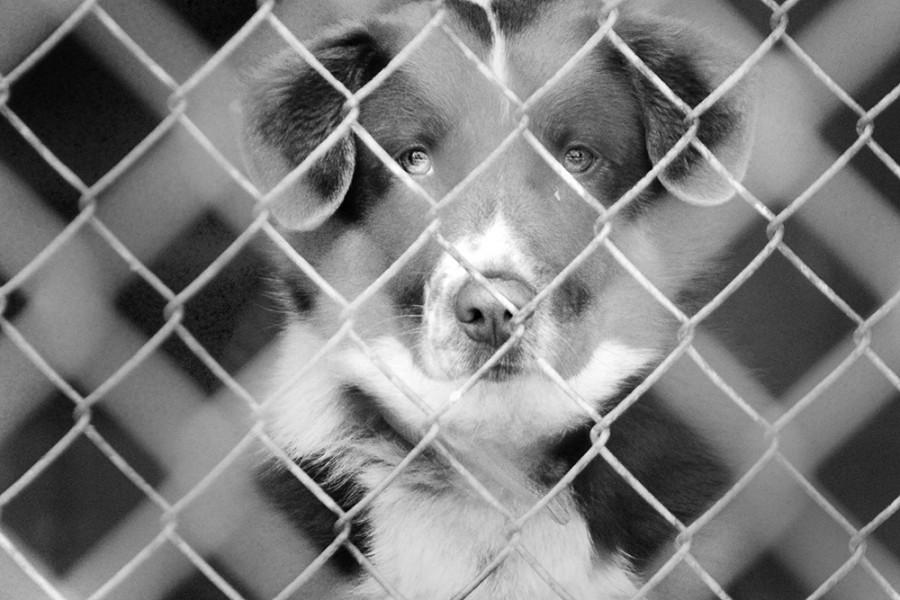Dogs suffer when left outside in cold
A dog looks through the gate into the parking lot at the Coles County Animal Shelter. The shelter provides indoor and outdoor pens for its dogs, and provides all its animals with blankets, towels and beds.
March 10, 2015
During the winter, many dogs and other pets are at risk if their owners leave them outside in cold temperatures.
Jason Wallace, the assistant manager of the Coles County Animal Shelter, said the shelter gets calls if the dogs do not have adequate shelter.
“Sometimes their water bowl is frozen; we need to get them adequate shelter so their water doesn’t freeze,” he said. “We change the water frequently, make sure the dog has water.”
Letting animals out in freezing temperatures for long periods of time is dangerous.
Annie Morrison, the inventory manager and veterinary assistant in Mattoon’s Albin Animal Hospital, said a dog’s body temperature can decrease.
“They can get hypothermia; they can suffer from that,” Morrison said.
The animals can get frostbite on parts of their feet when standing on the ice, and in especially cold weather, they can also get frostbite on their ears.
Morrison said if the frostbite gets bad, the animals can suffer deformities.
“We get strays that were found when it was bitterly cold outside,” Morrison said.
The dog’s coat matters in being protected from the cold.
“Big dogs with a thick coat, like huskies, are warmer than dogs like Doberman pinchers with short haired coats,” Wallace said. “Those guys get cold.”
He said the dogs also have problems with the ground being wet.
“We had a call on a dog tied outside; the dog was in the mud,” Wallace said.
Wallace said dogs must have water and a proper doghouse available to be outside.
A doghouse that fits the legal regulations needs three sides, a roof and a floor.
Owners who leave dogs outside without shelter and who fail to provide a doghouse that fits these regulations face consequences.
They have 24 hours to fix the situation. If that does not happen, they have more significant consequences.
“They have to appear in court and make a court appearance to explain why they don’t have that stuff,” he said.
If the shelter really feels like the dog is in danger, they will bring the dog to the shelter. The owner can then go to court to get the dog back, and a judge will decide if that is allowed.
The fee to have a dog picked up is $25. Boarding a dog is $5.
“Some people get dogs, they think it’s a great idea, then they stick it on a chain, and that’s where it lives,” Wallace said.
These dogs that are kept outside sometimes do not have water.
“They put the dog outside while they go to work; there are many reasons they might leave a dog outside,” Wallace said. “Some people just don’t care.”
Wallace said the shelter had one instance of someone who kept their dog in an igloo doghouse with no floor.
“The house was flipped, so they had no protection from the snow,” he said. “We gave the owner 24 hours to put a bottom on the igloo.”
Other situations occur when the shelter has to step in as well.
Wallace said shelter workers had to take a dog away after the police taskforce found out they were making drugs.
“We have to go in when the owner is deceased as well; there was an instance where we took cats from people who were hoarding,” he said.
The shelter does not like taking dogs away from people, however.
“We only have 32 dog kennels, and when the kennels are full we have to put the dogs to sleep,” he said.
This is why the shelter workers do what they can to prevent the dogs from being taken away.
“We distribute straw, where we went out and bought straw and put it in the doghouse,” he said. “It helps keep them warm.”
The straw is used as an insulator so the dog is not laying on a cold floor.
“If we seize an animal, it’s with a good reason and good intent,” Wallace said. “A lot of times, the last thing we want do to is take the animal; we want to educate as well.”
While the animals suffer physically when they are left outside, they suffer mentally when they are taken to unfamiliar places.
“They get stressed; you’re taking them out of their home, putting them somewhere they don’t know,” Wallace said. “They’re terrified, they shake, cry, whine, all that.”
Wallace said people need to make sure they have the proper things for their dog before getting one.
“They need proper water, food, dog houses,” he said.
Cassie Buchman can be reached at 581-2812 or cjbuchman@eiu.edu.

![[Thumbnail] Eastern's Old Main was quiet Thursday morning while educators who had left the office to strike picketed outside.](https://www.dailyeasternnews.com/wp-content/uploads/2025/04/Strike_01_LT_O-800x1200.jpg)












![[Thumbnail Edition] Senior Foward Macy McGlone, getsw the ball and gets the point during the first half of the game aginst Western Illinois University,, Eastern Illinois University Lost to Western Illinois University Thursday March 6 20205, 78-75 EIU lost making it the end of their season](https://www.dailyeasternnews.com/wp-content/uploads/2025/03/WBB_OVC_03_O-1-e1743361637111-1200x614.jpg)














![[thumbnail edition] Assistant Coach of the Linebackers, Rodman Noel talking to the linebackers about their positions at O'Brien Field on the Eastern Illinois University campus, Charleston Ill.](https://www.dailyeasternnews.com/wp-content/uploads/2025/04/FB_24_O-1-e1744671213207-1200x609.jpg)
![[THUMBNAIL EDITION] (From left to right) Head football coach Chris Wilkerson works with his son student assistant coach Peyton Wilkerson at football practice at O'Brien Field on the Eastern Illinois University campus on Thursday.](https://www.dailyeasternnews.com/wp-content/uploads/2025/04/FB_25_O-1-e1744234837107-1200x596.jpg)











































